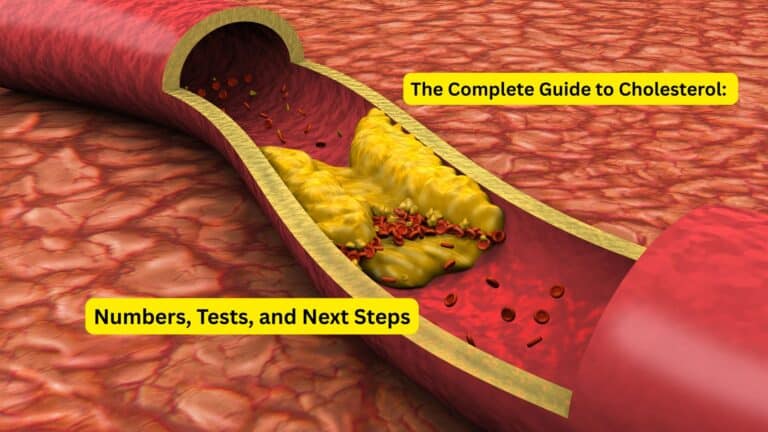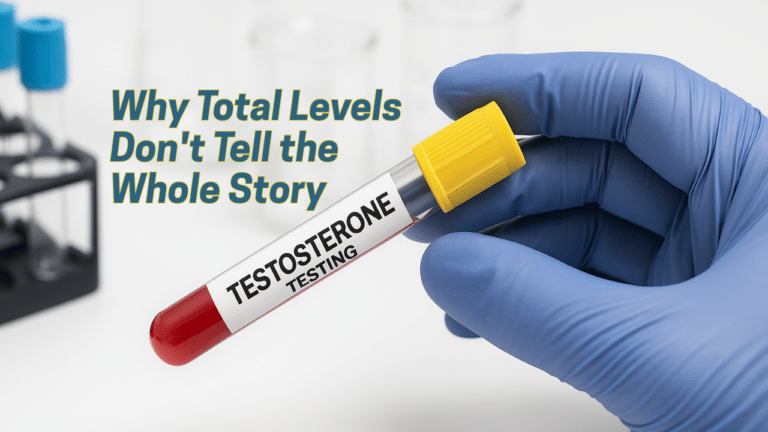Tracking heart health encompasses monitoring three critical dimensions: biomarkers revealed through blood tests, vital signs like blood pressure and heart rate, and emerging device-based signals from wearables and digital diagnostic tools. This comprehensive approach to cardiovascular monitoring empowers individuals to detect risks early and make informed decisions about their health. The following guide provides a practical roadmap for combining accessible home monitoring tools with targeted laboratory testing to create a proactive heart health strategy.
The Core Metrics to Track
Understanding which cardiovascular metrics matter most can transform how you approach heart health prevention. The key lies in tracking both immediate indicators like blood pressure and underlying risk factors revealed through biomarker testing. These measurements work together to provide a complete picture of your cardiovascular status and help identify potential issues before they become serious problems.
Blood Pressure & Heart Rate
Home blood pressure monitoring stands as one of the most impactful tools for cardiovascular health management. Research demonstrates that structured home BP monitoring significantly improves blood pressure control and reduces cardiovascular events compared to clinic-only measurements. When selecting a home monitor, choose a device validated by the British Hypertension Society or similar organization, ensuring the cuff fits your arm properly.
For optimal results, take two readings in the morning and evening for three consecutive days each week, then average these values. Normal blood pressure ranges below 120/80 mmHg, with readings consistently above 130/80 mmHg indicating hypertension requiring medical attention. Log your measurements consistently, as trends over time provide more valuable insights than isolated readings.
Heart rate monitoring through wearables complements blood pressure tracking by revealing patterns in resting heart rate, heart rate variability, and recovery after exercise. Persistent elevations in resting heart rate above 100 beats per minute or significant decreases in heart rate variability may signal underlying cardiovascular stress worth discussing with your healthcare provider.
Lipid Profile & A1C
Your lipid profile serves as a fundamental assessment of cardiovascular risk, measuring LDL cholesterol, HDL cholesterol, triglycerides, and total cholesterol levels. Modern guidelines emphasize non-HDL cholesterol as a comprehensive marker that includes all atherogenic lipoproteins. Optimal LDL cholesterol levels vary based on individual risk factors, with high-risk patients targeting levels below 70 mg/dL.
Hemoglobin A1C testing reveals average blood glucose levels over the preceding two to three months, making it essential for assessing cardiometabolic risk. Even in non-diabetic individuals, A1C levels above 5.7% indicate prediabetes and increased cardiovascular risk. Annual testing suffices for most adults, though those with diabetes or prediabetes may require more frequent monitoring.
The combination of lipid profiles and A1C testing provides insight into metabolic syndrome, a cluster of conditions that dramatically increases heart disease risk. When these markers trend upward together, lifestyle interventions become particularly important for preventing progression to clinical cardiovascular disease.
Inflammation: hs-CRP
High-sensitivity C-reactive protein (hs-CRP) measures systemic inflammation, which plays a crucial role in atherosclerosis development and cardiovascular events. This biomarker helps identify residual cardiovascular risk even when cholesterol levels appear well-controlled. Levels below 1.0 mg/L indicate low risk, 1.0-3.0 mg/L suggest moderate risk, and above 3.0 mg/L signal high risk for future cardiovascular events.
hs-CRP testing proves particularly valuable for individuals with intermediate cardiovascular risk based on traditional factors like cholesterol and blood pressure. Elevated levels may warrant more aggressive preventive interventions, including lifestyle modifications and potentially medication therapy. However, acute infections or inflammatory conditions can temporarily elevate hs-CRP, so timing of testing matters.
Consider hs-CRP testing annually if you have multiple cardiovascular risk factors, or every two to three years for general screening in adults over 40. This biomarker works best when interpreted alongside traditional risk factors rather than in isolation.
Cardiac Biomarkers
Brain natriuretic peptide (BNP) and N-terminal pro-BNP (NT-proBNP) serve as powerful indicators of heart failure and cardiac stress. These biomarkers rise when the heart’s ventricles stretch due to increased pressure or volume, making them valuable for both diagnosing heart failure and monitoring treatment effectiveness. Normal NT-proBNP levels vary by age, with values above 125 pg/mL in patients under 75 years warranting further cardiac evaluation.
Troponins (cardiac troponin I and T) indicate heart muscle damage and prove essential for diagnosing heart attacks. While traditionally used in emergency settings, high-sensitivity troponin tests can detect very small amounts of cardiac injury that may predict future cardiovascular events. Elevated troponins always require immediate medical attention and should never be monitored solely at home.
Emerging biomarkers like microRNAs show promise for early cardiovascular risk detection, though these remain primarily research tools. Recent advances in cardiac biomarker research suggest that panels of multiple biomarkers may eventually provide more precise risk stratification than individual markers alone.
From Clinic to Couch: Tools & Technologies
The landscape of home cardiovascular monitoring has evolved dramatically with advances in digital health technology. Modern tools now enable individuals to track sophisticated metrics previously available only in clinical settings. These technologies bridge the gap between periodic medical visits, providing continuous insights into cardiovascular health while maintaining the convenience of home-based monitoring.
Validated Home BP Monitors & Wearables
Today’s home blood pressure monitors achieve accuracy comparable to clinical devices when properly validated and calibrated. Look for monitors bearing the British Hypertension Society seal or American Heart Association validation, which ensures accuracy within 5 mmHg of mercury sphygmomanometer readings. Automated upper-arm cuffs generally provide more reliable results than wrist-based monitors.
Modern wearable devices complement traditional blood pressure monitoring by tracking additional cardiovascular metrics including resting heart rate, heart rate variability, and physical activity levels. While wearables cannot replace medical-grade monitoring, they excel at identifying trends and encouraging consistent health behaviors. The key lies in pairing these consumer devices with periodic professional-grade measurements and laboratory testing for the most comprehensive health picture.
When selecting wearables for cardiovascular monitoring, prioritize devices that provide raw data export and long-term trend analysis. Features like irregular heartbeat detection and guided breathing exercises add value for users focused on heart health optimization.
Digital Acoustic Biomarkers (CABs)
Digital stethoscopes and smartphone-based cardiac monitoring apps now capture acoustic biomarkers that correlate with cardiovascular risk. Third heart sound (S3) detection and electromagnetic acoustic transduction (EMAT) measurements help identify early signs of heart failure and other cardiac conditions. Recent systematic reviews demonstrate that these cardiac acoustic biomarkers can predict heart failure outcomes with increasing accuracy.
These technologies work by analyzing subtle sounds and vibrations produced by the heart that may not be audible to the human ear. While digital acoustic monitoring shows promise for heart failure risk stratification, clinical validation continues to evolve. Current applications focus primarily on monitoring known heart conditions rather than general screening.
The accessibility of smartphone-based cardiac monitoring represents a significant advancement in democratizing heart health technology. However, these tools work best as supplements to, rather than replacements for, traditional cardiovascular monitoring approaches.
Point-of-Care & Multiplex Biosensors
Rapid diagnostic devices now enable simultaneous measurement of multiple cardiac biomarkers within minutes rather than days. Advanced biosensor technologies can detect troponins, BNP, and other cardiac markers using small blood samples, potentially revolutionizing early cardiac event detection. These multiplex platforms show particular promise for emergency and point-of-care settings.
Current research focuses on developing biosensors sensitive enough to detect cardiovascular risk markers before symptoms appear. While many of these technologies remain in development or limited clinical use, they represent the future direction of personalized cardiovascular monitoring. The combination of high sensitivity and rapid results could enable earlier interventions and better outcomes.
For consumers, these advances suggest that home-based biomarker testing may become increasingly sophisticated and accessible. However, professional interpretation of biomarker results remains essential for appropriate clinical decision-making.
How to Build a Practical Monitoring Plan
Creating an effective heart health monitoring strategy requires balancing comprehensive data collection with practical sustainability. The most successful monitoring plans integrate simple daily habits with periodic comprehensive assessments. This approach ensures consistent tracking without becoming overwhelming or interfering with normal life routines.
Weekly Home Routine
Establish a consistent weekly routine that includes blood pressure monitoring on Monday, Wednesday, and Friday mornings and evenings. Take two consecutive readings each session, waiting one minute between measurements, then record the average. This schedule provides adequate data for trend analysis while remaining manageable long-term.
Incorporate daily heart rate and activity monitoring through your chosen wearable device, paying attention to resting heart rate trends and heart rate recovery after physical activity. Set up automated data syncing to your health app or tracking spreadsheet to minimize manual data entry. Weekly review of your accumulated data helps identify patterns and potential concerns before they become problematic.
Weight monitoring twice weekly provides additional cardiovascular insight, as sudden weight gain may indicate fluid retention associated with heart failure. Combine these measurements with subjective assessments of energy levels, shortness of breath, and exercise tolerance to create a comprehensive weekly health snapshot.
Quarterly/Annual Lab Panels
Schedule comprehensive lipid panels, A1C testing, and hs-CRP measurement annually if you have no known cardiovascular risk factors, or every six months if you have diabetes, hypertension, or other risk conditions. Consider adding BNP or NT-proBNP testing if you experience unexplained shortness of breath, fatigue, or have risk factors for heart failure.
Walk-In Lab testing enables convenient, affordable access to these essential biomarkers without appointment scheduling. Fast for 9-12 hours before lipid testing for accurate results, but you can eat normally before hs-CRP and cardiac biomarker tests. Stay well-hydrated before all blood draws to ensure adequate sample collection.
Focus on trends over time rather than individual test results, as cardiovascular risk develops gradually. Create a simple spreadsheet or use a health app to track your biomarker values alongside your home monitoring data. This integrated approach reveals patterns that might not be apparent when viewing data sources in isolation.
Red Flags & Escalation Path
Recognize warning signs that require immediate medical attention rather than continued home monitoring. Chest pain or pressure, especially when accompanied by shortness of breath, nausea, or arm pain, demands emergency evaluation regardless of your monitoring data. Similarly, blood pressure readings consistently above 180/110 mmHg require urgent medical care.
Gradual changes in exercise tolerance, increasing shortness of breath with normal activities, or unexplained fatigue may indicate developing heart problems worth discussing with your healthcare provider within days rather than waiting for your next routine visit. Wearable devices that detect irregular heart rhythms or significant changes in resting heart rate patterns also warrant prompt medical consultation.
Establish clear thresholds for when your home monitoring data should trigger healthcare system engagement. For example, decide in advance to contact your provider if your average weekly blood pressure exceeds your target range for two consecutive weeks, or if your resting heart rate increases by more than 10 beats per minute sustained over several days without explanation.
Evidence Snapshot: What Recent Studies Show
Current cardiovascular research emphasizes the value of combining traditional monitoring approaches with emerging technologies for comprehensive risk assessment. Recent evidence supports the effectiveness of home-based monitoring programs while highlighting the potential of new diagnostic approaches. Understanding these research findings helps inform evidence-based decisions about which monitoring strategies offer the greatest benefit.
Cardiac acoustic biomarkers like S3 gallop detection and EMAT measurements demonstrate significant promise for predicting heart failure outcomes in clinical studies. Research published in 2024 shows these digital biomarkers can identify patients at risk for heart failure hospitalizations with accuracy comparable to traditional biomarkers. This technology may eventually enable earlier interventions that prevent progression from asymptomatic cardiac dysfunction to clinical heart failure.
Multiplex biosensor development continues advancing rapidly, with new platforms enabling simultaneous measurement of multiple cardiac biomarkers from single blood samples. Recent studies demonstrate that these systems can detect troponins, BNP, and inflammatory markers with sensitivity approaching laboratory-grade testing. While clinical implementation remains limited, these technologies suggest a future where comprehensive cardiac risk assessment becomes increasingly accessible.
One in three American adults has hypertension, making home blood pressure monitoring a critical public health tool. Structured home monitoring programs consistently demonstrate improved blood pressure control compared to clinic-only management, with benefits extending to reduced cardiovascular events and improved medication adherence. The integration of biomarker testing with home vital sign monitoring strengthens cardiovascular risk assessment beyond what either approach achieves alone.
FAQs
What are the most useful blood tests for tracking heart health?
The most valuable blood tests include a comprehensive lipid panel measuring LDL, HDL, and triglycerides, hemoglobin A1C for metabolic health assessment, and high-sensitivity C-reactive protein for inflammation status. For individuals with suspected or known heart failure, BNP or NT-proBNP testing provides crucial information about cardiac function and helps guide treatment decisions.
Can I monitor my heart health at home effectively?
Yes, home monitoring using validated blood pressure cuffs and wearable devices provides valuable cardiovascular health insights when combined with periodic laboratory testing. The key to effective home monitoring lies in consistency, proper technique, and understanding when home data should prompt professional medical evaluation. Regular tracking of trends rather than focusing on individual readings maximizes the value of home monitoring efforts.
What are cardiac acoustic biomarkers?
Cardiac acoustic biomarkers represent digitally derived features from heart sounds that correlate with cardiovascular conditions. Examples include third heart sound (S3) detection and electromagnetic acoustic transduction (EMAT) measurements, which recent research shows can help predict heart failure risk and guide treatment decisions. These technologies use advanced signal processing to identify acoustic patterns not detectable by traditional stethoscope examination.
Are new biosensors reliable?
Emerging biosensor technologies show significant promise for rapid, accurate cardiovascular biomarker detection, with some systems approaching laboratory-grade accuracy for multiple markers simultaneously. However, clinical pathways for implementing these technologies continue evolving, and professional medical interpretation remains essential. Current research demonstrates impressive technical capabilities, but widespread clinical adoption depends on further validation and regulatory approval.
How often should I test?
Testing frequency depends on your individual cardiovascular risk profile and existing conditions. Most adults benefit from annual lipid panels and A1C testing, with targeted hs-CRP testing every two to three years for general screening. Individuals with diabetes, hypertension, or known cardiovascular disease may require more frequent testing every three to six months. BNP or NT-proBNP testing frequency should be guided by symptoms and clinician recommendations rather than routine screening intervals.
Conclusion
Effective heart health tracking combines regular home monitoring of blood pressure and heart rate with periodic laboratory assessment of key biomarkers including lipids, A1C, and inflammatory markers like hs-CRP. When symptoms or risk factors suggest heart failure, adding BNP or NT-proBNP testing provides crucial diagnostic information. The power of this approach lies in tracking trends over time rather than reacting to individual measurements, enabling early identification of cardiovascular risks before they progress to serious problems. Walk-In Lab testing makes this comprehensive monitoring approach accessible and affordable, empowering proactive cardiovascular health management through convenient, confidential testing that puts you in control of your heart health journey.
Medical Disclaimer: This content is for informational purposes only and does not substitute professional medical advice. Always consult with healthcare providers before making changes to your monitoring routine or treatment plans.






